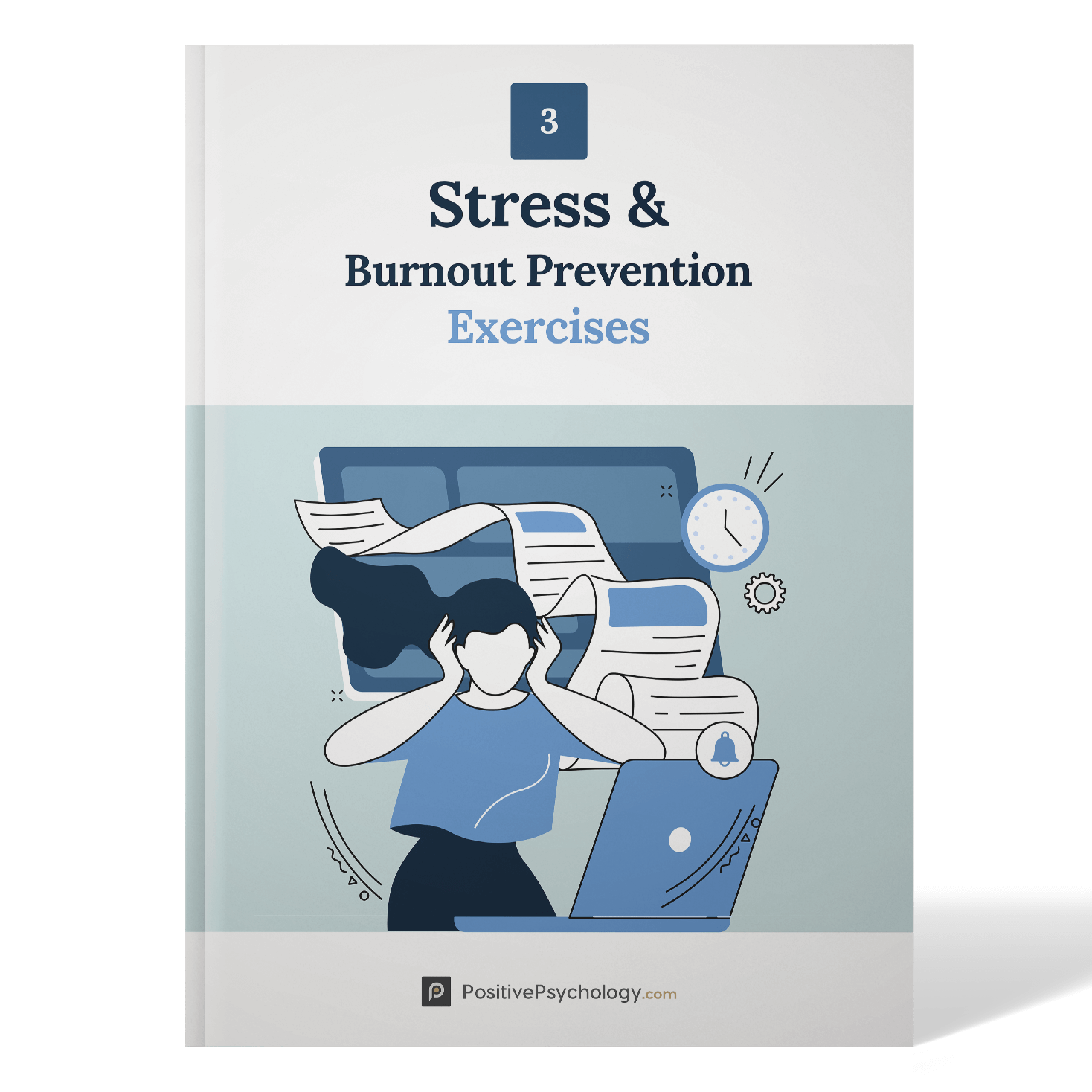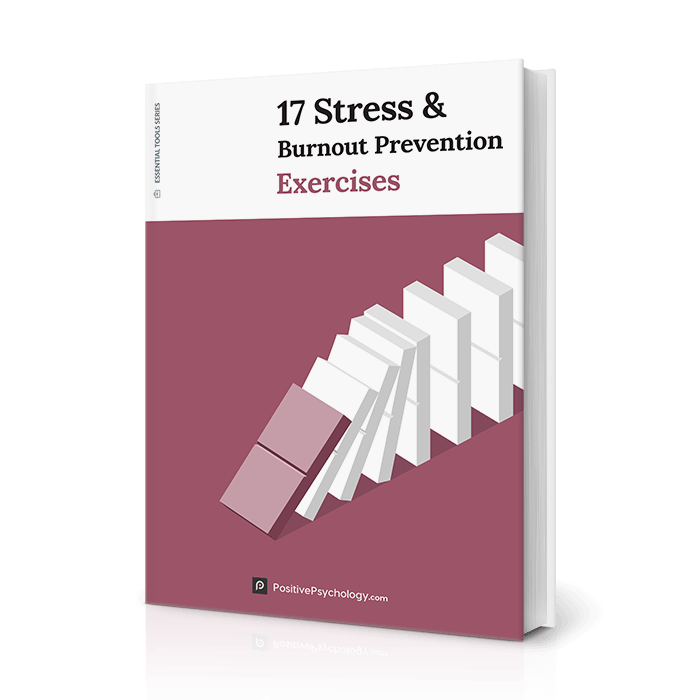How to Prevent Burnout in the Workplace: 20 Strategies
 Burnout is recognized as a break between what people are and what they have to do, and it is typically experienced as emotional exhaustion or depersonalization (Olson et al., 2019; Kolomitro, Kenny, & Sheffield, 2019).
Burnout is recognized as a break between what people are and what they have to do, and it is typically experienced as emotional exhaustion or depersonalization (Olson et al., 2019; Kolomitro, Kenny, & Sheffield, 2019).
Its impact is considerable.
Indeed, burnout among physicians, which is twice that of the general public, leads to emotional and physical withdrawal from work and can negatively impact safe, high-quality healthcare for patients (Olson et al., 2019).
The effect of burnout is widespread. The impact of increasing workload, a perceived lack of control, and job insecurity lead to high turnover, reduced productivity, and poor mental health (Kolomitro et al., 2019).
This article explores the warning signs of burnout in the workplace and what we can do to prevent it.
Before you continue, we thought you might like to download our three Stress & Burnout Prevention Exercises (PDF) for free. These science-based exercises will equip you and those you work with, with tools to manage stress better and find a healthier balance in your life.
This Article Contains:
14 Warning Signs of Workplace Burnout
In increasingly busy, high-pressure working environments, employees often become the shock absorbers, taking organizational strain and working longer, more frantic hours (Kolomitro et al., 2019).
The long-term impact is burnout, identified by “lower psychological and physical wellbeing, as well as dissatisfaction, and employee turnover” (Kolomitro et al., 2019).
“Burnout occurs when an individual experiences too much stress for a prolonged period,” writes researcher Susan Bruce (2009). The employee is left feeling mentally, emotionally, and physically exhausted. Not only that, they are less productive at work, show reduced concern for others, and are more likely to miss work (Bruce, 2009).
Its effects are not only felt by the individual. In education, for example, burned-out teachers can negatively impact their students’ education (Bruce, 2009).
Organizations with burned-out staff experience low productivity, lost working days, lower profits, reduced talent, and even damage to their corporate reputation (Bruce, 2009).
So how do we recognize the warning signs of burnout?
Once we can spot early predictors and signs of burnout, we can take action.
Writing for the Harvard Business Review, Elizabeth Grace Saunders (2021) describes how, without realizing and on the verge of burnout, she was “perpetually exhausted, annoyed, and feeling unaccomplished and unappreciated.”
There are many early predictors, indicators, and manifestations of stress that contribute to burnout.
The following factors are recognized as early predictors of burnout (Maslach & Leiter, 2008):
- Job demands that exceed human limits.
- Role conflict leading to a perceived lack of control; being under pressure from several, often incompatible, demands that compete with one another.
- Insufficient reward and lack of recognition for the work performed, devaluing both the work and the worker.
- Lack of support from the manager or team, consistently associated with exhaustion.
- Work perceived as unfair or inequitable, caused by an effort–reward imbalance.
- Relationship between the individual and the environment leading to feelings of imbalance or a bad fit. Such incongruity connects with excessive job demands and unfairness at work.
The following feelings, physical complaints, and thought patterns accompany stress and manifest in the workplace (Bruce, 2009):
- Feelings:
Tired, irritable, distracted, inadequate, and incompetent. - Physical:
Muscular aches and body pain, headaches, increased or reduced appetite, weight change, and nausea. - Emotional:
Feeling trapped, hopeless, and depressed. - Mental:
Poor concentration, muddled thinking, and indecisiveness.
Stress in the workplace can manifest as:
- Regularly arriving late to work
- Absenteeism
- Reduced goals, aspirations, and commitment
- Increased cynicism and apathy
- Poor treatment of others
- Relationship difficulties
- Increase in smoking and alcohol consumption
- Making careless mistakes
- Obstructive and uncooperative behavior
- Overspending
While burnout is unique for every individual, it can be spotted and avoided.
8 Strategies to Prevent Employee Burnout

- Work satisfaction
- Organizational respect
- Employer care
- Work–life integration
Balancing all four factors is essential to overall employee wellbeing and reduces the likelihood of long-term and ultimately overwhelming pressure.
The following strategies can help find that balance and protect against burnout (Saunders, 2021; Boyes, 2021).
Workload
When workload and capacity are in balance, it is possible to get work done and find time for professional growth, development, rest, and work recovery.
Assess how you are doing in each of the following activities:
- Planning your work.
Do you know what work is coming? What will you be working on next week? Do you have a shareable plan? - Delegating tasks.
Sometimes we steer away from handing over work to others, but it can be positive for both parties. - Saying no.
Saying no is necessary when you have too much work or someone else could perform it. - Letting go of perfectionism.
Sometimes producing a perfect piece of work is not required; sometimes, good enough is all that is needed.
If you are experiencing any of the symptoms of burnout, try to focus on each of the above actions. Proactive effort to reduce workload can be highly effective at removing some stressors impacting burnout.
Control
Feeling out of control, a lack of autonomy, and inadequate resources impact your ability to succeed at what you are doing and contribute to burnout.
Do you get calls from your boss or answer emails late into the night or over the weekend?
Consider how you can regain control. Agree on a timetable for when you are available and what resources you need to do your job well. Gaining a sense of control over your environment can increase your sense of autonomy.
Community
Community is essential to feeling supported. While you may not be able to choose who you work with, you can invest time and energy in strengthening the bonds you share with your coworkers and boss.
Positive group morale, where you can rely on one other, can make the team more robust and reduce the likelihood of burnout.
Fairness
A sense of fairness at work can be helped by feeling valued and recognized for the contributions you make.
Let it be known that you would like to be mentioned as a contributor or become involved in presenting some of the team’s successes.
Value mismatch
“Burnout isn’t simply about being tired,” writes Saunders (2021). When your values cannot align with those of your organization, you may need to consider whether it is time to look for new opportunities.
Determine if you can find compatibility in your current position or whether another organization might be better suited to your values.
Task balancing
After delivering something highly demanding (cognitively, emotionally, or physically), it may be beneficial to switch to a less complex task.
Swapping between tasks of varying difficulty on a daily, weekly, or monthly basis can be an excellent way to regain balance and give yourself a break.
After putting together a complex report, presentation, or analysis, why not plan the rest of your week for organizing emails into folders?
Mental breaks
We sometimes feel unable to stop. We check emails while in line for a coffee and type up notes on the flight back from a business meeting. While it can seem essential when you are busy to keep pushing ahead, it is vital to take breaks. Use spare time to read a book, listen to music, talk to a friend, or run through breathing exercises.
Taking time out for yourself is crucial to your wellbeing and will ultimately benefit your performance.
Physical breaks
Stress and tension take their toll physically. You may notice tight shoulders or headaches. Learning to recognize times when you are most stressed or anxious can help. When you do, find a moment to take some slow breaths or go for a walk.
Mindfulness techniques can be incredibly helpful in hitting reset and regaining focus.
6 Programs & Initiatives for HR Professionals
While burnout is damaging to the employee, it is also expensive for the business. In the U.S. alone, the cost of absenteeism is $300 billion a year in insurance, reduced productivity, and staff turnover (Peart, 2021).
HR professionals have an essential role to play in reducing the effect and likelihood of burnout within the working environment (Castanheira & Chambel, 2010).
Putting in effective workplace wellness practices can help. For them to be effective, they must be at an organizational level, reducing stress at work, fostering employee wellbeing, and upping employee engagement (Peart, 2021; Chamorro-Premuzic, 2021).
According to clinical psychologist and leadership consultant Natalia Peart (2021), it is possible to create a working environment that reduces stress. To do this, we must build positive, stress-reducing environments that integrate with day-to-day working habits.
Increase psychological safety
Staff must see work as nonthreatening, allowing them to work and collaborate effectively. We can help perceptions of psychological safety by:
- Giving staff clear goals
- Making sure they feel heard by management
- Making work challenging yet non-threatening
Create a culture where it is okay to fail. Recognize and encourage people who think outside the box.
Regular workday breaks
Our attention and ability to focus are limited. After two hours (or less), our concentration reduces significantly (Peart, 2021), which could make us more likely to make mistakes, become less creative, and lose the ability to solve complex problems.
Staff must be encouraged to take breaks without feeling guilty. It is vital that they take time away from their desk regularly and as needed.
Placing entries in the calendar can help by setting aside time. And leading by example can help reduce stress and create an environment conducive to consistent performance.
Private spaces
While open offices are commonplace, they can be a cause of ongoing distraction.
Create spaces where staff can work uninterrupted and encourage them to turn off email and other messaging services at predefined times.
Set work boundaries
There will be times when working outside core hours may be necessary, but there is still a need to agree on typical workday expectations. Regularly answering emails late in the evening or over the weekend can increase employee anxiety and the sense of never leaving work.
Setting boundaries, flexible working, and providing additional time off can restore work–life balance.
Increase employee engagement
Improving the connection staff feel with their workplace and coworkers can heighten job satisfaction while reducing stress (Peart, 2021).
Engagement can be promoted through a culture of:
- Transparency
It is vital to understand how work aligns with corporate goals. - Using strengths and talents
When people use their strengths, they feel more competent and engaged. - Autonomy
Staff are “43% less likely to experience high levels of burnout” when they decide on how and when they complete their work (Peart, 2021). - Recognition
Supporting and recognizing good work reduces stress while promoting a sense of belonging. - Sense of purpose
Feeling a sense of purpose in what we do adds meaning to otherwise tedious tasks. Share the company’s goals and communicate their positive effect on the community.
Hire better bosses
Good leaders must be hired or created, shielding employees from stress. However, rather than being seen as a source of calm and inspiration, managers often become the cause of stress. This is especially the case when managers make poor decisions, are abusive, or alienate their staff.
Hiring teams must take more time scrutinizing candidates who apply for leadership roles, identifying their empathy, emotional intelligence, and ability to perform under pressure.
Preventing Burnout When Working From Home

While working from home removes commuting times and can allow us to take our children to school, it may be overshadowed by long working hours and a sense that we never leave work.
“The risk of burnout when working from home is substantial” write Laura Giurge and Vanessa Bohns (2021).
In an environment where the line between work and home life can quickly become blurred, it is crucial to our mental health that we agree upon and implement boundaries.
Even a non-urgent email sent after hours can create a sense of urgency or leave us with the weight of the action on our mind until we log on the next day. Working from home can also cause staff to feel indebted to their employer and mistakenly believe they need to work more intensely for more hours each day.
There are ways to create boundaries when working from home and reduce loneliness and burnout (Giurge & Bohns, 2021; Moss, 2021):
- Put on work clothes.
Wearing something different when working from home can create a sense of performing a work activity in a separate environment. - Commute to work.
Even a walk around the block before heading to a dedicated space to work can create a feeling of separation. - Maintain temporal boundaries.
Create a work schedule that fits your needs and your organization’s, such as taking the children to school and stopping for lunch. Respect your own time and that of your colleagues. They may have different schedules for their commitments. - Create an out-of-office reply.
Create an automated email reply for when you are performing non-work activities or need time to focus uninterrupted on your tasks. - Virtual coffee breaks.
Staff should be encouraged to take time away from the desk for a walk with a friend, a casual chat, or to grab a coffee. Taking even 10 minutes will ultimately benefit concentration and focus. Finding ways to “carve out non-work time and mental space” are crucial when working from home, where boundaries are so unclear (Giurge & Bohns, 2021). - Reducing loneliness.
While working from home can be incredibly beneficial or even necessary, it may become a source of loneliness. Scheduling an in-office day once a month (as long as a time can be agreed upon and works for all remote workers) where staff can get together and have a catch-up can improve bonds between workers while creating a sense of shared goals.
15 Minutes a day to prevent burnout – Paul Koeck
PositivePsychology.com’s Relevant Resources
We have many resources that can help with managing stress, overcoming obstacles, and dealing with difficult situations.
- 5-4-3-2-1 Stress Reduction Technique
Use your five senses to ground yourself in the moment and slow down thinking. - Coping With Stress
Identifying and understanding what causes you stress can help you regain control over how you respond. - Coping – Stressors and Resources
Consider past, current, and anticipated stressors, and plan coping strategies to manage them. - It Could Be Worse
Build resilience by challenging unhelpful thought patterns and processes.
17 Stress & Burnout Prevention Exercises
If you’re looking for more science-based ways to help others manage stress without spending hours on research and session prep, this collection contains 17 validated stress management tools for practitioners. Use them to help others identify signs of burnout and create more balance in their lives.
A Take-Home Message
Humans are curious.
We need a degree of stress to prevent boredom and frustration.
However, too much can lead to poor decision making and ineffective communication, negatively impact mental health, and ultimately cause burnout (Bruce, 2009).
Stress not only takes a toll on our physical and mental wellbeing, but also narrows our outlook, making long-term strategic thinking more difficult (Peart, 2021).
“Burnout is experienced as emotional exhaustion or depersonalization” (Olson et al., 2019) and is the ultimate destination for long-term stress. It can harm physical health, psychological wellbeing, and performance at work (Olson et al., 2019; Maslach & Leiter, 2008).
While unpleasant for the individual, it can also damage the organization, leading to failing performance, absenteeism, and disengagement.
Spotting the early warning signs, positive leadership, and protective and proactive policies can avoid or reduce burnout. A balanced work culture promotes a positive work environment and a growth mindset.
There is a proven link between job satisfaction and mental health, so finding a good balance for stress is vital. Low job satisfaction at work can predict depression, low self-esteem, and anxiety (Bruce, 2009).
Use this article’s guidance to recognize dangers or early warning signs in yourself, colleagues, or clients. Then take some steps discussed to help reduce or prevent damaging environments and invest in employees’ wellbeing and performance.
We hope you enjoyed reading this article. Don’t forget to download our three Stress & Burnout Prevention Exercises (PDF) for free.
- Boyes, A. (2021). How to get through an extremely busy time at work. In HBR guide to beating burnout (pp. 29–34). Harvard Business Review Press.
- Bruce, S. P. (2009). Recognizing stress and avoiding burnout. Currents in Pharmacy Teaching and Learning, 1(1), 57–64.
- Castanheira, F., & Chambel, M. J. (2010). Reducing burnout in call centers through HR practices. Human Resource Management, 49(6), 1047–1065.
- Chamorro-Premuzic, T. (2021). Just hire better bosses. In HBR guide to beating burnout (pp. 189–194). Harvard Business Review Press.
- Giurge, L. M, & Bohns, V. K. (2021). How to avoid burnout while working from home. In HBR guide to beating burnout (pp. 35–40). Harvard Business Review Press.
- Hyett, M. P., & Parker, G. B. (2015). Further examination of the properties of the Workplace Well-Being Questionnaire (WWQ). Social Indicators Research, 124(2), 683–692.
- Kolomitro, K., Kenny, N., & Sheffield, S. L. M. (2019). A call to action: Exploring and responding to educational developers’ workplace burnout and well-being in higher education. International Journal for Academic Development, 1–14.
- Maslach, C., & Leiter, M. P. (2008). Early predictors of job burnout and engagement. Journal of Applied Psychology, 93(3), 498–512.
- Moss, J. (2021). Helping remote workers avoid loneliness and burnout. In HBR guide to beating burnout (pp. 173–180). Harvard Business Review Press.
- Olson, K., Sinsky, C., Rinne, S. T., Long, T., Vender, R., Mukherjee, S., … Linzer, M. (2019). Cross-sectional survey of workplace stressors associated with physician burnout measured by the Mini-Z and the Maslach Burnout Inventory. Stress and Health, 35(2), 157–175.
- Peart, N. (2021). Making work less stressful and more engaging for your employees. In HBR guide to beating burnout (pp. 139–148). Harvard Business Review Press.
- Saunders, E. G. (2021). Six causes of burnout, and how to avoid them. In HBR guide to beating burnout (pp. 23–28). Harvard Business Review Press.
Let us know your thoughts
Read other articles by their category
- Body & Brain (49)
- Coaching & Application (57)
- Compassion (26)
- Counseling (51)
- Emotional Intelligence (24)
- Gratitude (18)
- Grief & Bereavement (21)
- Happiness & SWB (40)
- Meaning & Values (26)
- Meditation (20)
- Mindfulness (45)
- Motivation & Goals (45)
- Optimism & Mindset (34)
- Positive CBT (28)
- Positive Communication (20)
- Positive Education (47)
- Positive Emotions (32)
- Positive Leadership (18)
- Positive Parenting (4)
- Positive Psychology (33)
- Positive Workplace (37)
- Productivity (16)
- Relationships (46)
- Resilience & Coping (36)
- Self Awareness (21)
- Self Esteem (38)
- Strengths & Virtues (32)
- Stress & Burnout Prevention (34)
- Theory & Books (46)
- Therapy Exercises (37)
- Types of Therapy (64)





What our readers think
Wow, a very well-researched report with clearly explained content.
Although the articles took the form of a generalised format which is why there was a less evidence-based approach, the author did a marvellous work.
Question: Is burnout predictive? In an education study, how would predictive burnout be validated in an evidence-based educational environment?
Hi George,
Thank you for your comment and your question. Burnout is most certainly predictive, and therefore also preventative. There has been a plethora of research on protective factors of burnout as well as what can actually predict burnout.
I think this article and this article might be of interest to you since they discuss predictive burnout in educational environments.
I hope this helps.
Kind regards,
-Caroline | Community Manager